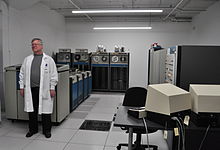
The SDS Sigma series is a series of third generation computers[1][2][3] that were introduced by Scientific Data Systems of the United States in 1966.[4] The first machines in the series are the 16-bit Sigma 2 and the 32-bit Sigma 7; the Sigma 7 was the first 32-bit computer released by SDS. At the time, the only competition for the Sigma 7 was the IBM 360.
Memory size increments for all SDS/XDS/Xerox computers are stated in kwords, not kbytes. For example, the Sigma 5 base memory is 16K 32-bit words (64K bytes). Maximum memory is limited by the length of the instruction address field of 17 bits, or 128K words (512K bytes). Although this is a trivial amount of memory in today's technology, Sigma systems performed their tasks exceptionally well, and few were deployed with, or needed, the maximum 128K word memory size.
The CII 10070 computer was a rebadged Sigma 7 and served as a basis for the upgraded, yet still compatible, Iris 50 and Iris 80 computers. The Xerox 500 series computers, introduced starting in 1973, were also compatible upgrades to the Sigma systems using newer technology.
In 1975, Xerox sold its computer business to Honeywell, Inc. which continued support for the Sigma line for a time.

The Sigma 9 may hold the record for the longest lifetime of a machine selling near the original retail price[citation needed]. Sigma 9 computers were still in service in 1993. In 2011, the Living Computer Museum in Seattle, Washington acquired a Sigma 9 from a service bureau (Applied Esoterics/George Plue Estate) and has made it operational.[5] That Sigma 9 CPU was at the University of Southern Mississippi until Nov. 1985 when Andrews University purchased it and took it to Michigan. In February 1990, Andrews University via Keith Calkins sold and delivered it to Applied Esoterics in Flagstaff, Arizona. Keith Calkins made the Sigma 9 functional for the museum in 2012/13 and brought up the CP-V operating system in Dec. 2014. The various other system components came from other user sites, such as Marquette, Samford and Xerox/Dallas.
- ^ Nelson, Richard R.; New York University Graduate School of Business Administration Center for Science and Technology Policy (1982). Government and technical progress: a cross-industry analysis. Pergamon Press. p. 208. ISBN 9780080288376.
In 1965-67, SDS introduced its third-generational Sigma Series (...).
- ^ Krickx, Guido Armand Marie Jules (1988). Historical evidence on the evolution of vertical exchange mechanisms: examples from the computer systems industry. UCLA. pp. 167, 416.
- ^ "IC DIGITAL LOGIC MODULES. T Series. Description and Specifications" (PDF) (Revision 5 ed.). September 1969. THE SDS APPROACH TO MODULES, p. -1 (3). Retrieved 2019-03-19.
- ^ "Computers that will not die – The SDS Sigma 7".
- ^ "Computer Room Exhibits". The Living Computer Museum. Retrieved September 4, 2014.